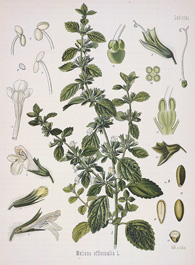Enlivening Lemon Balm
By Audrey Stallsmith

Search Windsor Castle, elves, within and out:
Strew good luck, ouphes, on every sacred room
That it may stand till the perpetual doom,
In state as wholesome as in state 'tis fit,
Worthy the owner, and the owner it.
The several chairs of order look you scour
With juice of balm and every precious flower. . .
William Shakespeare, Merry Wives of Windsor V, v
I am somewhat miffed at my lemon balm plants just now, since I suspect they may have been what originally lured the four-lined plant bug into my garden, where it has since become a plague. Although that pest especially loves plants in the mint family—such as balm—it is happy to move on to almost any others!
The fact that I still have those lemon balms, however, probably proves how much I value them. I do have to cut them back several times every year, because of the tarnished hue the bug gives them. That may be just as well, however, as they tend to look seedy after they have bloomed anyhow.
Officially dubbed Melissa officinalis, Melissa being the Greek for “bee,” lemon balm is very attractive to those honey hoarders. So much so that Gerard advised that “The hives of bees, being rubbed with the leaves of Bawme, causeth the bees to keep together, and causeth others to come onto them.”
Growing to two feet with square stems and a delectable citrus scent, lemon balm was once thought to drive away sadness, or at least to relieve anxiety. Its odor is especially refreshing during the hot months when we are all craving lemony drinks—for which the balm makes an excellent garnish. You might want to try adding a sprig to fruit salads and fish dishes as well.
Balm can actually cool fevered brows too, by making the patient sweat, and soothe an irritated digestive tract. It is supposed to fight viruses as well, and is prescribed in Europe to treat cold sores. Once used to knit up cuts and other wounds, it has been found to contain eugenol which dulls pain and polyphenols which can fight bacteria.
I used to have a very lemony cologne which I loved to dab on during the summer. The ancient Carmelite water was probably similar, since it contained balm, lemon peel, nutmeg, and angelica root. Though I understand that the people of that day drank it as well as wearing it!
Balm is sometimes added to potpourris too, but loses much of its scent after it is dried. Is it any wonder that, in the Language of Flowers, this herb stands for “pleasant company?”
Melissa officinalis image is from Kohler's Medizinal-Pflanzen, courtesy of the Missouri Botanical Garden.








